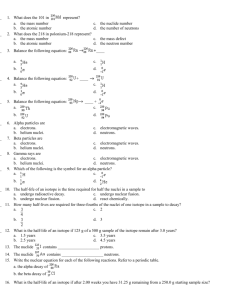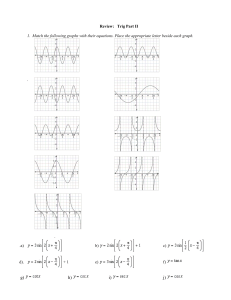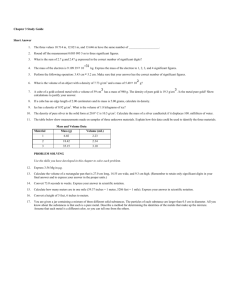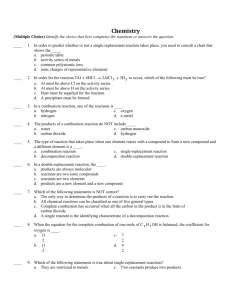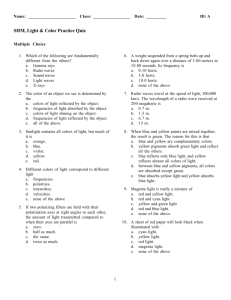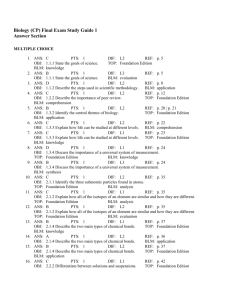final exam study guide 4th term
advertisement
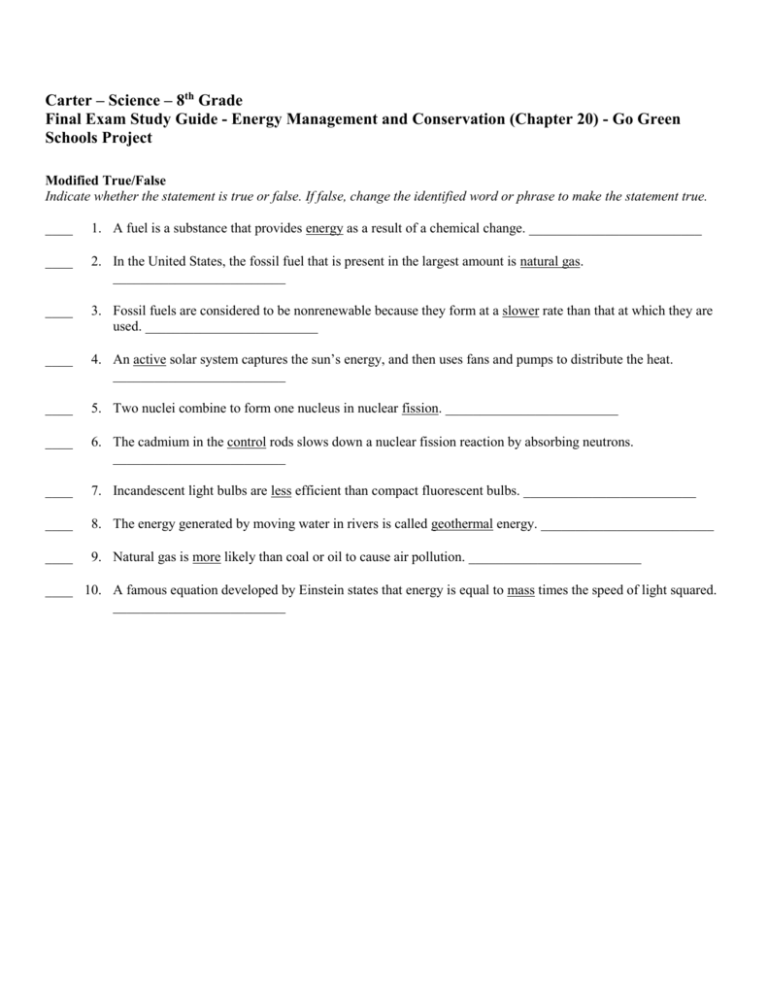
Carter – Science – 8th Grade Final Exam Study Guide - Energy Management and Conservation (Chapter 20) - Go Green Schools Project Modified True/False Indicate whether the statement is true or false. If false, change the identified word or phrase to make the statement true. ____ 1. A fuel is a substance that provides energy as a result of a chemical change. _________________________ ____ 2. In the United States, the fossil fuel that is present in the largest amount is natural gas. _________________________ ____ 3. Fossil fuels are considered to be nonrenewable because they form at a slower rate than that at which they are used. _________________________ ____ 4. An active solar system captures the sun’s energy, and then uses fans and pumps to distribute the heat. _________________________ ____ 5. Two nuclei combine to form one nucleus in nuclear fission. _________________________ ____ 6. The cadmium in the control rods slows down a nuclear fission reaction by absorbing neutrons. _________________________ ____ 7. Incandescent light bulbs are less efficient than compact fluorescent bulbs. _________________________ ____ 8. The energy generated by moving water in rivers is called geothermal energy. _________________________ ____ 9. Natural gas is more likely than coal or oil to cause air pollution. _________________________ ____ 10. A famous equation developed by Einstein states that energy is equal to mass times the speed of light squared. _________________________ Short Answer Use the diagram to answer each question. Electricity Production by Energy Source 11. Which of the energy sources shown are fossil fuels? 12. Which energy sources shown are considered to be renewable? 13. Which energy source produces the greatest percentage of electricity? 14. Which two of the named sources shown produce the most air pollution? Which two produce the least? 15. What type of nuclear reaction is currently used to produce electricity? 16. Predict how this graph is likely to change 100 years from now. Explain your answer. Essay 17. One home is heated by burning wood in a fireplace, while another similar home is heated by burning oil. Which method uses less fuel? Why? 18. Briefly explain how wind energy can be used to generate electricity. 19. Why must the United States purchase oil from other countries? What problem can this situation sometimes cause? 20. Describe three advantages nuclear fusion would have over nuclear fission. 21. How is hydroelectric power an indirect form of solar energy? 22. Give two examples of ways to conserve energy at home. 23. Describe what happens in a nuclear fusion reaction. Why have scientists been unable to control fusion reactions? 24. Explain how insulation increases the efficiency of heating and cooling systems. Final Exam - Energy Managment and Conservation (Chapter 20) - Go Green Scools Project Answer Section MODIFIED TRUE/FALSE 1. ANS: REF: BLM: 2. ANS: T p. ES-354 knowledge F, coal PTS: OBJ: 3. ANS: REF: BLM: 4. ANS: REF: STA: 5. ANS: 1 DIF: L1 REF: p. ES-356 ES.11.1.2 Name the three major fossil fuels. BLM: knowledge T PTS: 1 DIF: L2 p. ES-360 OBJ: ES.11.1.3 Explain why fossil fuels are considered nonrenewable resources. application T PTS: 1 DIF: L1 p. ES-362 OBJ: ES.11.2.1 Explain the forms of energy provided by the sun. Gr7.P.10.c| Gr7.E.10.c BLM: knowledge F, fusion PTS: OBJ: BLM: 6. ANS: REF: BLM: 7. ANS: REF: BLM: 8. ANS: 1 DIF: L1 REF: p. ES-374 ES.11.3.3 Describe what takes place in a nuclear fusion reaction. knowledge T PTS: 1 DIF: L2 p. ES-372 OBJ: ES.11.3.2 Explain how a nuclear power plant produces electricity. comprehension T PTS: 1 DIF: L2 p. ES-377 OBJ: ES.11.4.1 Name ways to ensure that there will be enough energy for the future. comprehension F, hydroelectric PTS: OBJ: STA: 9. ANS: 1 DIF: L2 REF: p. ES-364 ES.11.2.2 Identify and describe various renewable sources of energy. Gr7.P.10.c| Gr7.E.10.c BLM: comprehension F, less PTS: OBJ: 10. ANS: REF: BLM: PTS: 1 DIF: L1 OBJ: ES.11.1.1 Explain how fuels provide energy. 1 DIF: L2 REF: p. ES-359 ES.11.1.2 Name the three major fossil fuels. BLM: comprehension T PTS: 1 DIF: L2 p. ES-370 OBJ: ES.11.3.1 Describe what happens during a nuclear fission reaction. comprehension SHORT ANSWER 11. ANS: coal, petroleum, and natural gas PTS: 1 DIF: L2 REF: p. ES-356 OBJ: ES.11.1.2 Name the three major fossil fuels. BLM: 12. ANS: hydroelectric and possibly “other” analysis PTS: 1 DIF: L2 REF: p. ES-364 OBJ: ES.11.2.2 Identify and describe various renewable sources of energy. STA: Gr7.P.10.c| Gr7.E.10.c BLM: analysis 13. ANS: coal, at 59.3 percent PTS: 1 DIF: L2 REF: p. ES-356 OBJ: ES.11.1.2 Name the three major fossil fuels. BLM: analysis 14. ANS: Petroleum and coal produce the most; hydroelectric and nuclear produce the least. PTS: 1 DIF: L2 REF: p. ES-356| p. ES-358| p. ES-359| p. ES-364| p. ES-372| p. ES-373 OBJ: ES.11.1.2 Name the three major fossil fuels. BLM: analysis 15. ANS: nuclear fission PTS: 1 DIF: L2 REF: p. ES-372 OBJ: ES.11.2.2 Identify and describe various renewable sources of energy. STA: Gr7.P.10.c| Gr7.E.10.c BLM: comprehension 16. ANS: Answers may vary, but students may predict that the hydroelectric, “other,” and nuclear wedges will be bigger, and that the fossil fuel wedges will be smaller because there will be more conservation/less availability of nonrenewable fossil fuels. PTS: 1 DIF: L3 REF: p. ES-360 OBJ: ES.11.1.3 Explain why fossil fuels are considered nonrenewable resources. BLM: synthesis




